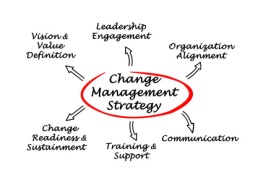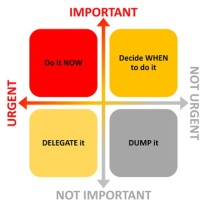I wrote in a previous post about why many change management initiative fail and made some suggestions as to what to do to swing the balance in favor of success.
If according to research, many transformation initiatives fail, operationally and from experience, I know that many do indeed succeed!
Reflecting on all the good practices I witnessed over the years at different organizations that contributed to transformation success, I started thinking about how to summarize all those best practices in a short post and in doing so, I came across an article first published in the HBR in 2005 on the subject and entitled « The Hard Side of Change Management » by Harold Sirkin, Perry Keenan and Alan Jackson (see HBR The Hard Side of Change Management).
In this article, the authors highlight some key « hard factors » that must be taken into account if change is to be managed successfully and I thought it useful to review the authors ideas here as a pragmatic way of summarizing many of the good practices I have used or come across in the past and that have helped me achieve success in the transformation projects I managed or was associated with in recent years.
Indeed, in their article, Sirkin et al. focus only on the “hard factors” contributing to change management success because in their opinion, if “Soft” issues are important for success, managing these aspects alone isn’t sufficient to implement transformation projects. For them, “Soft” factors don’t directly influence the outcomes of many change programs”.
 For Sirkin et al, we should focus first on the “hard factors” because as they say, “if companies don’t pay attention to the “hard issues” first, transformation programs will break down before the soft elements come into play”. Whether you agree our not, it seems to me obvious that it is indeed critical to be alert to the importance of these hard factors as a “sine qua non” for leading change successfully.
For Sirkin et al, we should focus first on the “hard factors” because as they say, “if companies don’t pay attention to the “hard issues” first, transformation programs will break down before the soft elements come into play”. Whether you agree our not, it seems to me obvious that it is indeed critical to be alert to the importance of these hard factors as a “sine qua non” for leading change successfully.
Hard factors have three distinct characteristics:
- First, companies are able to measure them in direct or indirect ways.
- Second, companies can easily communicate their importance, both within and outside organizations.
- Third, businesses are capable of influencing those elements quickly.
On the basis of research they performed on a panel of 225 companies, the authors established a consistent correlation between the outcomes of change programs and four specific hard factors:
- Duration
- Integrity
- Commitment
- Effort
They called these variables the DICE variables as they “could load them in favor of project success”.
The way organizations combine these four factors creates a continuum – from projects that are set up to succeed to those that are set up to fail. Let’s look at those four factors briefly and the different success drivers that these four factors generate if organizations focus sufficiently on them before project launch.
1.Duration
We are all anxious for projects that take too long to implement and we have all felt the pressure placed on trying to complete projects rapidly, the assumption being that the longer the project goes on, the more likely it is to fail.
Lots of reasons are given: possible loss of momentum, the window of opportunity may close, objectives may be forgotten, key supporters may leave, problems may accumulate. These indeed are very real risks and very good reasons for moving fast.
However, according to the authors’ research, a long project reviewed frequently is more likely to succeed than a short project that isn’t reviewed frequently and it really is the case of “Hurrying slowly”!
What is critical for project success indeed is not project life span but in fact the time between reviews!
What does this mean in terms of actionable success drivers?
D1: Companies must set formal project milestones reviews with clearly defined deliverables for each milestone and the project cannot move on to the next milestone if all the deliverables for that milestone have not been met.
deliverables for each milestone and the project cannot move on to the next milestone if all the deliverables for that milestone have not been met.
If this is the case, the project team must work with the project sponsor to understand why, take the necessary corrective actions and learn from the experience to prevent problems from recurring later on.
D2: These milestone reviews must be formal meetings and the project team must provide in advance to the project review team (that includes the sponsor) a concise report of its progress and evidence that the deliverables have been met. Reviews should happen at least every 8 weeks and even more frequently for critical projects.
D3: Sponsors and project teams must have authority to address any issues blocking progress and must be empowered to take corrective actions, add extra or different resources or suggest a new direction.
So at least 3 key drivers that act on project duration in a positive way.
2.Integrity
By performance integrity is meant the extent to which companies can rely on teams of managers, supervisors and staff to execute change projects successfully. Execution of course is key.
Change management projects are particularly complex and challenging and of course require highly skilled project leaders and team members capable of executing the plan.
Often, companies either don’t have enough “star performers” or senior managers don’t want to sacrifice their “stars” to change projects because they fear regular work will suffer. But success depends on allocating the best talent to the project and companies have to convince senior managers to free up their stars. So what can we do?
D4: Companies must accept to free up their “stars” while making sure that day-to-day operations don’t falter.
D5: Change initiatives need to be well led. Managing change means dealing with a wide range of activities, resources, pressures, unforeseen events and ensuring team cohesion

and meeting deadlines. This means choosing carefully not only a “star performer” but that “star” must have the right project management skills.
Senior management must therefore choose carefully the project leader and the key members of the project team and a precondition for successful selection is defining in advance and publishing the criteria by which candidates will be evaluated.
Good project leaders should have the following skills:
- Excellent problem solving skills
- Results focused
- Methodical while tolerating ambiguity
- Possess organizational savvy
- Accept accountability for decisions
- Be highly motivated and self starting
- Possess humility and not crave the limelight
D6: The project sponsor should take personal responsibility for selecting candidates based on these criteria and the senior executive team should agree the candidate selected. Senior managers demonstrate their commitment to the project by involving themselves directly in the recruitment of the project manager and team members.
I have often seen CEOs and senior executives become very involved in the recruitment process and each time, it has had a strong impact on project success.
 D7: Project leaders and key team members should have a clear mandate and this should be defined in a project mission statement and their objectives of course should be included in the annual appraisal process. Roles and responsibilities should be clear, expectations and deliverables should be clear and shared within the organization as quite often, the project will cut across organizational and functional responsibilities and therefore potential for conflict and resistance to change.
D7: Project leaders and key team members should have a clear mandate and this should be defined in a project mission statement and their objectives of course should be included in the annual appraisal process. Roles and responsibilities should be clear, expectations and deliverables should be clear and shared within the organization as quite often, the project will cut across organizational and functional responsibilities and therefore potential for conflict and resistance to change.
D8: Of course, it is not enough to recruit and appoint your project team. Companies must reward and recognize project leaders and teams when the project is successfully completed and ensure that the success feeds into the career management process of all concerned so that taking on the role of project leader is seen as a stepping stone to success and encourages “star performers” to see the role as one that will further their careers and not as a burden.
So at least 5 actionable drivers that impact positively on Performance Integrity and on project execution.
3.Commitment
For Sirkin et al., companies need to obtain the commitment of two different groups of people if they want their change projects to take root:
- the most influential executives (not necessarily the top titles)
- The grass roots: people who must deal with the new systems, processes or ways of working.
D9: Concerning influential executives, senior managers must be seen to “walk the talk” and even when the senior managers feel they are doing so, quite often, this is not perceived so by the grass roots. So senior managers must communicate again, again and again and do three times as much as they would think is necessary.
Of course, senior managers must not only support the project but they must constantly explain the “Why” of the proposed change. There can be very many good reasons why senior managers don’t want to do this but it is always vital to communicate clearly on the reason for change and what it means for employees. So Communicate the “Why” constantly and it is always better to communicate too much than not enough.
Having said that, problems are often caused by inconsistent or confusing or contradictory messages coming from management and especially in tense situations, employees perceive these confusing messages as indicative of something hidden.
D10: So a lot of effort must be dedicated to preparing and sharing the communication with

top and middle managers so that management from top to bottom can speak with one voice and align their messages so that one consistent message is delivered throughout the organization.
The authors stress that companies often underestimate the importance of middle managers and staff in driving change and often postpone communicating with them until very late. Delaying communication can create confusion and even alienate staff and so it is always vital to communicate early and involve middle managers and key staff.
D11: Companies should seek the support of middle managers and key staff by communicating early to them on the “Why” of the change and ensure the same message is understood and shared by all.
Finally, organizations often underestimate their ability to build staff support. Reaching out to staff can in fact turn them into change champions.
D12: Don’t hesitate to reach out to key staff early in the project if you want to offer them the chance to become change champions. Quite often, even if the change requires sacrifices and even los of jobs, staff can react positively if the changes are presented clearly and they are given a chance to voice their concerns.
So at least 4 key drivers that impact on the Commitment of middle managers and staff in a positive way.
4.Effort
One important aspect too frequently neglected by organizations is that staff are already busy with their day to day tasks and if they are have to deal not only with their daily work but also with changes to systems or processes or tools, they will quite often not be able to cope and resistance to change ensues.
So an important effort must be made by project teams to calculate the extra work beyond existing responsibilities to introduce the change. The authors offer a figure of 10% as being an acceptable limit but of course this is only a guideline.
D13: Project leadership must be conscious of the impact of the extra work on staff, calculate the extra workload and limit the extra work to no more than10%.

However, for employees already fully-loaded, companies must decide whether to take away some of the regular work from key employees participating in the transformation project or rid them of the discretionary or non-essential tasks.
D14: Senior management should ensure key employees can offload unnecessary or non-essential tasks. This can be done by outsourcing non-essential tasks, bringing in interims or even postponing or cancelling such tasks.
In addition, companies can also review all the projects in the operating plan and assess which ones are critical for the transformation. This can mean delaying or rescheduling some projects to free up stars and key resources to focus on priority projects. If this happens, senior management should be mindful to explain clearly to the project teams impacted on the reasons for the change so that they remain committed and motivated.
D15: Senior management must be ready to look again at all the projects in the plan, reprioritize according to the critical impact of each project and reallocate key resources to the most critical projects if necessary.
So at least 3 actionable drivers that impact positively employee work load.
The authors go on to outline how they created a scoring system based on these 4 factors and that allows managers to predict the chances of project success.
This scoring system allows managers to categorize projects into one of three categories:
- Win (the project statistically seem likely to succeed)
- Worry (the project’s outcome is hard to predict)
- Woe (the project outcome is totally unpredictable or fated for mediocrity or failure.
We won’t discuss here the details of the DICE scoring system. However, the authors tell us that the DICE Framework and scoring system has been used by the Boston Consulting Group to predict the outcomes and guide the execution of more than 1000 projects worldwide and they indicate three key advantages that I think are important in building the foundations of change management success:
- Track projects: A scoring framework (DICE or any other) provides executives with an early warning system of potential problems in a transformation project because it gets senior management to review each project according to these four criteria and evaluate how effectively it has “allocated people, senior management time and other resources” to each project. As soon as a project shows poor scores, senior management is obligated to intervene and take the necessary steps to put the project back on course. It seems to me vital to build in to the change management process such an early warning system because it is always better to prevent than to cure and it’s no good closing the stable door if the horse has already bolted!!
- Manage portfolio of projects: large transformation programs can often contain many different projects and if the portfolio of projects is not managed well, these tasks can end up competing for attention and resources. By deploying the DICE framework (or a similar framework) from the outset, senior management can identify problem projects in the portfolio, focus execution expertise and senior management attention where it is most needed rather than allow certain projects capture all the resources. In other words, senior executives can set certain critical projects up for success and work on the less critical projects in the “Worry” zone progressively to get them into the “Win” zone. Indeed, as the authors point out, “when companies are trying to overhaul themselves, they shouldn’t have all their projects in the Win zone. If they do, they are not ambitious enough and transformations should entail fundamental changes that stretch the organization.
- Force Conversations: The authors point out that it is already difficult to get consensus from senior managers on what factors contribute most to ensuring transformation success and this applies even in an organization using the DICE Framework or some other similar way of predicting the outcomes of a transformation project. The real value of DICE is that it provides senior managers with a common framework to debate questions such as “Why do we see the project in different ways?” and “What can we agree to do to ensure the project will succeed?” Simply put, DICE provides senior managers with a common language and forces the right discussions to take place.
D16: So it seems to me important to define and implement a project portfolio scoring system (DICE or a similar system) that allows senior management to predict project success proactively as well as build a consensus through strong discussions on what actions are required to optimize the chances of those projects in the “Worry” or “Woe” zones.
These are some very practical and actionable items that lay the foundations for change management success because not only do they ensure the main building blocks are in place but also because they contribute to helping senior management and project transformation teams have the necessary discussions that help them predict success rather than simply focusing on what went wrong.
It could be said that these drivers don’t necessarily guarantee success. In my view, they may not guarantee success but success is certainly inhibited if they are not implemented at project launch.
In my view, it is clear that every transformation project needs to be founded on “hard factors” that include:
- A strong senior management sponsor that communicates constantly on the reason and goals of the change project.
- A competent, results focused project manager.
- A competent, motivated and engaged team.
- Reward and recognition for successful projects teams.
- Middle managers and staff that understand the reasons for change and have the opportunity to participate in the decision making phase and not only in the execution phase.
- A project schedule, milestones and defined deliverables at each milestone.
- A formal review for each milestone by senior executives.
- Project managers empowered to take corrective action when things go wrong.
- A limit on the extra work expected of key players who have the possibility to offload or even postpone unnecessary tasks.
- A “project success predictability” scoring system (DICE or other such system) that forces discussions amongst senior management on how to predict future success (rather than focusing on what went wrong) and on what actions to take to manage projects from “Woe” to “Worry” to “Win”.
And as JFK once said,“all of this doesn’t happen, it has to be made to happen”.

What do you think?


















